Hudson, Elizabeth, Mrs (McKechnie Section 3)
b. 1750-54; fl. 1794 - c. 1802)
Recorded simply as Mrs Hudson by Jackson (Dictionary) and other authorities. Her first name has not hitherto been known; I discovered it in the record of her marriage in the register of St Michael's Church, Bath, the city in which she grew up. What we know of the life of this artist (who was more prolific of work in hair and in wax than of silhouettes) is derived from advertisements in local newspapers, her trade labels, and from the registers of St Michael's Church. Foskett suggests that Mrs Hudson may be identifiable with the Mrs Hudson who exhibited at the Free Society in 1764, but, since we now know that the profilist did not marry until 1777, this theory must be discounted.
She was born Elizabeth Chilcot, the daughter of Henry Chilcot, a jeweller who lived on the corner of Green Street, Bath, opposite St Michael's Church. Henry Chilcot's wife, as we can gather from an advertisement published in a local newspaper in 1776, was previously a Mrs Fonteneau. (Presumably first married to a Frenchman, she may herself also have been of French extraction.) The registers of St Michael's Church do not record the christening of Elizabeth, who may have been born before the family took up residence in Green Street. They do, however, record the christening of Ann Chilcot (the daughter of Henry and presumably Elizabeth's younger sister) on 15 October 1755. Possibly Elizabeth was born between 1750 and 1754. There was in the city another family of Chilcots, who may have shared the same premises, for on 16 March 1758 and 3 August 1763 Ann and Rachel Chilcot, daughters of William and Ann Chilcot, were christened at St Michael's Church. In Park Street, Bristol, an old-established firm of jewellers of this name exists today.
To follow Elizabeth's career, we must now turn to advertisements. Jackson refers to an advertisement by Miss Chilcot in the Bath Chronicle of 8 December 1774, and her reference has been repeated by other writers, but I discovered that this advertisement was issued by Mrs Sarah Harrington (see Section One). The first two advertisements which concern us appeared together in the same newspaper almost exactly two years later, on 5 December 1776. The first advertisement mentions a school, run by Mrs Chilcot, which was to be opened at Christmas 1776 and which (as we know from a later advertisement) was still in existence on 23 January 1782:
Mrs. Chilcot (late Mrs. Fonteneau, who was for many years French teacher to the late Mrs. Emblin's, and Mrs. Patteine's school), purposes on Christmas next, opening a BOARDING & DAY SCHOOL, for young Ladies, in St. John's Court, Bath. A pleasant and airy situation.
Dancing, Music, Writing, & English Grammar, by approved Masters. French taught by Mrs. Chilcot, who will make it the common dialect of the school. Great regard & due Attention will be paid to the morals and improvements of these Ladies committed to her care.
N.B. Drawing on silk or sattin for embroidery, tambour, or muslin work by Mrs. Chilcot.
N.B. A shop and Apartment to be Lett in Wade's Passage.
Enquire of Mr. Chilcot.
The second advertisement (which immediately follows the first) contains the first reference to Elizabeth in a newspaper:
Chilcot, working Jeweller and Goldsmith, corner of Green Street, opposite St. Michael's Church, and at the Hotwells during the Season, for many years principal workman to Mr. Bellis, of Pall Mall, London. Makes new sets, and mends all sorts of Jewellery work, particularly in the Diamond way, on the best principles & newest designs, with every contrivance to answer their several purposes — seals set and engraved on stone or silver. Money for diamonds, old Gold and Silver.
Hair Work by Miss Chilcot, in all extensive forms, fancies & devices, likenesses, cyphers, urns, altars, trees, &c. Emblematic devices for mourning, love & Friendship, for rings, lockets, bracelets, buttons,
snuffboxes, &c.
Specimens to be seen at the Pump Room.
The mention of the shop to let in Wade's Passage at the end of the first advertisement may indicate that the Chilcots moved during 1776 from Wade's Passage to Green Street. This is only a possibility, for the record in the registers of St Michael's Church of the christening of Ann Chilcot suggests that, even as early as 1755, the family may have lived in Green Street, close to St Michael's Church. The paragraph on Elizabeth's work in the second advertisement does not refer to silhouettes, but only to what was probably her highly skilled work in hair, which she may have executed on wax bases. (This would explain her later proficiency in wax modelling.)
On 7 October 1777 Elizabeth Chilcot married William Hudson by license. The ceremony took place at St Michael's Church and was witnessed by Sarah Dover and by Cathryn Pool. Foskett lists three miniature painters named Hudson and with either the first name William or W. as their initial. To judge by the dates at which these artists exhibited, any of them might have been descended from William and Elizabeth Hudson. Perhaps the most likely descendant was William J. L. Hudson, who, Born in 1779. could well have been a son. On 18 February 1808 he obtained permission from the Court of Directors to go to India as a 'free mariner' on 21 July 1809. He married a Miss Eliza Philbrow, by whom he had at least six children, and lived for a time in Bengal. Early entries in the East India Register describe him as a miniature painter, but in entries for 1823-26 he is called a 'painter' or 'scene painter', and, in entries after 1827, a 'portrait painter'. He died in Calcutta on 6 July 1834, aged fifty-four. Foskett illustrates an example of his work.
Another William Hudson is known to have worked in Calcutta as a miniature painter as early as 1806 and as late as 1823. He too might have been a son of the Hudsons with whom we are concerned, but it seems unlikely that William and Elizabeth Hudson would have named two sons William. C. H. Hudson (Section Six) may likewise have been a son.
After the second of the two advertisements in the Bath Chronicle, the next known reference to the artist was an advertisement in Aris' Birmingham Gazette (27 September 1779). This, the first known published reference to Elizabeth under her married name, still mentions only her hair work:
HAIR WORK
MRS. HUDSON, late Miss CHILCOT, from BATH, takes the Liberty of informing the Nobility, Gentry, and her friends in particular, That she continues to take LIKENESSES as usual in their own Hair, for Rings, Lockets, and Bracelets; and if not allowed to be a Likeness, the Money to be returned — Specimens of her Performance may be seen at Mrs. Beaven's, No. 8, New-Hall Street — Time of Sitting only Twice, Ten Minutes each Time — Those Ladies and Gentlemen who please to honour her with their Commands, by directing a Line as above, shall be waited on in their own Houses.
This may indicate Mrs Hudson's first venture outside her native city. (Her mother was still advertising her boarding school in St John's Court, Bath, in the Bath Chronicle of 25 June 1778.)
It appears, therefore, that up to the end of the 1770s Mrs Hudson was only offering hair work, which included 'Likenesses made [in the sitter's] own Hair'. We do not know where she was living, or what she was doing, in the ensuing years up to 1789 (the year of the next known published reference to her). She ma)' have been living in Cavendish Street, London (this possibility is suggested by a reference in an advertisement published in Aris' Birmingham Gazette much later, in 1795). The rate books for the parish of St Marylebone, however, for the years 1785-1806 do not give the name Hudson as a householder in either Old or New Cavendish Street. If Mrs Hudson did have a studio in either of these streets (occupied then mostly by titled people) she was presumably a tenant. She may, of course, have been raising a family, including, perhaps, one of the William Hudsons mentioned above.
The published reference dating from 1789 is to be found in one of the volumes (II, page 516) of early press cuttings in the Victoria and Albert Museum, London: 'Mrs. Hudson and her Exhibition, Dramatic Sketches, &c, at Mr. Secard's Picture Gallery, Pall Mall, was received again on Thursday last by a numerous and genteel audience with universal approbation: we hear she intends repeating it tomorrow evening and the Saturday following by the particular desire of several Persons of Distinction.' We do not know whether Mrs Hudson had exhibited her work at Secard's Picture Gallery' previously, but her trade labels and advertisements dating from the 1790s suggest that the exhibits were wax models of some kind; perhaps they were used at the gallery in theatrical sketches. (Mr E. J. Pyke, the expert on wax portraits, has told me that, in his opinion, Mrs Hudson did not produce these, but wax models.)
In the course of research into Mrs Hudson's life, Mr Percy Higgs has discovered a good deal of information about Secard and his gallery, most of which, quite apart from its convection with Mrs Hudson, is of considerable interest, and which I therefore include here. Mr Higgs' research has been supplemented by information from the Survey of London (London County Council, London, 1960, vol. 29). Secard's gallery was in fact the original building which housed the Royal Academy before this was moved to Burlington House. The building was two doors west of Carlton House.
In 1774 Lewis Secard, a picture dealer, was assigned the lease of a shop which formed part of the premises in Pall Mall taken in 1765 by Richard Dalton, one of the founders of the Royal Academy, with a view to housing this institution. Dalton, himself an artist, had already tried, unsuccessfully, to use the building first as a print warehouse, and then as a private academy of art.
Matthew Pilkington, in A General Dictionary of Painters (London, 1829), states that Richard Dalton was born c. 1720, at Deane, in Cumberland, of which parish his father was rector. In his youth he was apprenticed to a coach painter in London; after his apprenticeship ended, he went to Rome, where he became acquainted with various noblemen. A meeting with Lord Charlemont led to his making the acquaintance of the Prince of Wales (the future George III), who, after he had succeeded to the throne, sent Dalton to collect paintings in Italy and also appointed him his librarian (this post was later changed to that of Keeper of the Royal Cabinet of Drawings and Medals). Dalton himself exhibited at some of the meetings of the Royal Academy and published a volume of prints, based on his own drawings, which illustrated Egyptian customs. Dalton thus managed to interest the King in the use by the Royal Academy of the premises in Pall Mall, and the first Royal Academy exhibition was held in the building in 1768. He died in 1791.
In 1771 many of the Academy's activities were transferred to Somerset House, and the lease of the Pall Mall building was acquired by James Christie, the famous auctioneer. Two shops were now situated one on each side of the main entrance to the building; one was managed by Lewis Secard, the other by William Randall, a bookseller. The rate books for St James's, Westminster, state that Lewis Secard paid the rates for his shop during the early 1790s, but not in 1795. It seems, therefore, that 'Mr Secard's Picture Gallery' had ceased to exist (at this address, at least) by the end of 1794. Secard seems to have used his gallery for diverse purposes. Among the entertainments which were presented there were lectures by a
Mr Cartwright on musical glasses.
1094
In view of the importance of these premises, in which Mrs Hudson worked, it is not surprising that she used the phrase 'from late Secard's' on her trade label (which could only have been used on profiles dated after 1794) and on the advertisement in Aris' Birmingham Gazette quoted below. We know from the advertisement of 1789, quoted above, that Mrs Hudson used Secard's gallery for her 'Exhibition, Dramatic Sketches &c' but there is no evidence that she produced silhouettes there.
We learn from an advertisement in Aris' Birmingham Gazette (21 December 1795) that Mrs Hudson, after either the termination of Secard's lease in Pall Mall or, possibly, his death, left London and started to tour the provinces. I have already suggested that this advertisement indicates that she might have lived in Cavendish Street during the 1780s, but it is perhaps more likely that, if she lived there at all, she would have done so for a time after leaving Secard's premises and before setting out for the provinces.
By Mrs. HUDSON,
From the late SECARD'S, Pall Mall, and Cavendish Street, London, and last from Oxford, Worcester, &c.
The most perfect LIKENESSES in Miniature Profile, from Five Shillings and Sixpence to Ten and Sixpence each. Profiles in Lockets, Bracelets, &c. from Fifteen Shillings to one Pound Five, superior to any Thing of the Kind ever yet attempted, and will last for Ages. Children of any Age taken in a neat and elegant Stile. Time of Sitting one Minute only Likewise modelling in Wax, and Miniature Likenesses in Colours upon Ivory.
Specimens of a great Variety of Profiles, Models in Wax, &c. to be seen from Ten till Two, and from Three till Six, at Miss Smith's, Confectioner, New Street, Birmingham.
Mrs. HUDSON begs Leave to inform those Ladies and Gentlemen who wish to honour her with their Commands, that her Stay will be for one Month only.
Ladies, &c. waited on at their own Houses, where there are three or more Outlines to be taken.
N.B. Profiles altered and dressed in the present Taste.
We learn from this that she visited Oxford first, then Worcester, and by December 1795 was in Birmingham. The 'Likenesses in Miniature Profile, which cost from Five Shillings and Sixpence to Ten Shillings and Sixpence' must have been profiles of the usual size painted on glass. (Mr J. A. Pollak has a dated silhouette of a Mrs Parker which is of this type.) Mrs Hudson also advertises profiles for lockets and bracelets 'from Fifteen Shillings to one Pound Five'. These higher prices are difficult to explain; Mr Elliott Levy owns a locket by Mrs Hudson which is painted on glass, not on ivory, and so one must assume that the extra cost of the profiles for lockets and bracelets was accounted for by the use of more expensive frames. Perhaps gilt metal frames cost fifteen shillings, gold frames ten shillings more. The style of hairdressing on Miss Levy's example appears to date from earlier than 1795; if Mrs Hudson did indeed paint silhouettes while she was still at Secard's gallery, this may be an example.
Mrs Hudson advertises modelling in wax, and also coloured portrait miniatures on ivory (no examples of which have yet been ascribed to her). It will be noted that she does not mention hair work.
No doubt during her visits to Oxford, Worcester and Birmingham, Mrs Hudson used her Trade Label No. 1 (which bears the phrase 'from the late Secard's'). As she says in her advertisement that she intends to stay in Birmingham for a month, Mrs Hudson probably remained in the city for part of January 1796. We know that she was in Coventry by April: Jackson records an advertisement in the Coventry Mercury (4 April 1796). It includes the phrase has taken over 150 in Birmingham'. This suggests either that Mrs Hudson stayed in Birmingham for longer than she had originally intended, or that she may have visited another centre after leaving Birmingham and before arriving in Coventry.
We know from her Trade Label No. 2 that Mrs Hudson was in Buxton in 1797 (the label was printed there, with this date). In Buxton the artist exhibited her wax models as well as advertising profiles. By this time she was between forty-five and fifty years old. Her stay in Buxton was evidently long enough to justify printing this new trade label, from which she omitted the reference w the late Secard's'.
How much longer Elizabeth Hudson continued in practice as a silhouette artist after her visit to Buxton we do not know. I have seen one profile, dating from c. 1800-1802, which may possibly be by Mrs Hudson. By that time she may have considered that she was of an age to retire, or she may then have given up profile painting (at which she seems to have worked for at the most about seven years) and continued touring with her wax models.
Mrs Hudson's Work
Mrs Hudson was prolific as an artist in hair work and as a modeller in wax, and she also painted portrait miniatures in colour. Here, however, we are concerned with her work (which, at its best, is of high quality) as a painter of profiles on glass. We cannot be certain, from available evidence, that she started to paint profiles before 1795. She painted on the under surface of convex glass. Before 1797 she worked on glass of marked convexity, with a dome shaped backing of composition covered in white satin. In 1797, at Buxton, she used a shallower convex glass, backed with flat pink plaster slabs. Even at the present day this pinkness shows up in contrast to the dead white plaster used by most artists, and flecks of vermilion pigment show on the back of these slabs. In Buxton, Mrs Hudson quoted a price range of 7s 6d to 12s 6d. Perhaps the higher price was for full-length work, since prices for jewellery work are given separately. If an example of her work is seen among a group of silhouettes, painted on glass, of mixed provenance, it is immediately recognizable from its colour. Only the sitter's face is painted in dead black, the clothing, shown with considerable transparency, being painted in a deep shade of brown. Hair is painted in fine strokes of deeper pigment against a fingerprinted base. These strokes appear sufficiently fine to have been painted either with a quill, or with a single-hair brush such as was used by miniature painters. The outlines of clothes are shown by somewhat coarser work in hatching and line. The treatment of bows and ribbons on men's wigs is also distinctive, the bow being formed in the shape of a crown. Another peculiarity of Mrs Hudson's style is her occasional use of Chinese white to highlight details. Now slightly yellow with age, this Chinese white is visible on the buttons worn by the officer in a volunteer regiment in one of the illustrated silhouettes.
1090
The bust-line termination shows as a thick line beneath the transparency and varies in shape, though it is usually of the simple concavity/convexity type. Sometimes there is no termination, and the profile is continued to the base of the oval. One illustrated silhouette, of a young man, shows the latter style, as does the almost half-length profile of a Mrs Thomas Cox, illustrated by Jackson (Dictionary); this, taken in 1796, was backed with wax and bore Trade Label No. 1.
1093
Mrs Hudson probably secured her basic outlines by mechanical means, since she advertises a time of sitting of only one minute.
Mrs Hudson's jewellery pieces, usually unsigned, are singular, for the profiles are painted on the under side of the usual convex glass, but backed with ivory. Most of the silhouettes are in pearwood frames 1093 (about 6 x 51/4 in.). One locket with some verre églomisé decoration has been seen.
Trade Labels
Two trade labels are known; both were used after Mrs Hudson had left London. No. 1 (on the illustrated profile of Mrs Parker dated May 1795) implies that Mrs Hudson had left Secard's Gallery, and cannot therefore have been used before 1794. It was probably used 1795-96.
Trade Label No. 2 (illustrated) was used at Buxton in 1797:
To be seen near the Cross, Buxton
H UDSON'S
Beautiful Collection of WAX WORK
The most perfect Likenesses taken in Miniature Profile
PAINTED ON GLASS
From 7s. 6d. w 12. 6d. each, Frames and Convex Glasses included.
Likewise PROFILES in LOCKETS, BRACELETS, &c., in a New and Elegant Style
From 15s. to £1. 5s. each (Time of sitting ONE MINUTE only).
N.B. Those who sit for their Likeness admitted to the Exhibition
GRATIS
BUXTON. 1797.
Ills. 115, 1088-1096, 1235
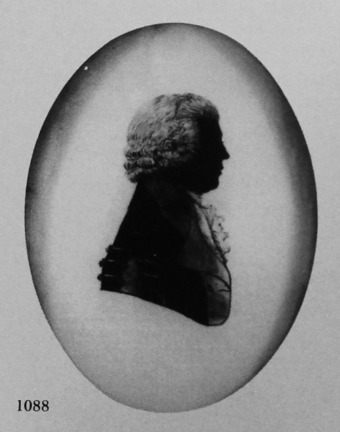
Unknown naval officer
Silhouette painted on convex glass, backed with composition covered with satin
May 1795
3 ¾ x 2 ¾ in./96 x 70mm.
Trade Label No. 1
Frame: pearwood
The sitter may have been the husband of Mrs Parker (1089).
J. A. Pollak collection
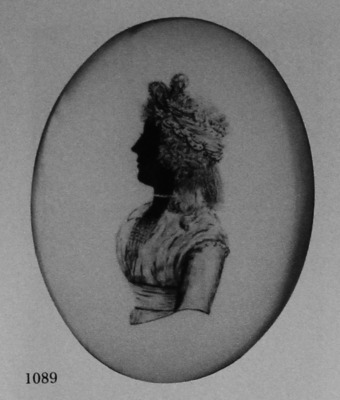
Mrs Parker
Silhouette painted on convex glass, backed with composition covered with satin
May 1795
3 ¾ x 2 ¾ in./96 x 70mm.
Trade Label No. 1
Frame: pearwood
Inscribed on the reverse, ‘Mrs Parker, aet. 55.’
J. A. Pollak collection
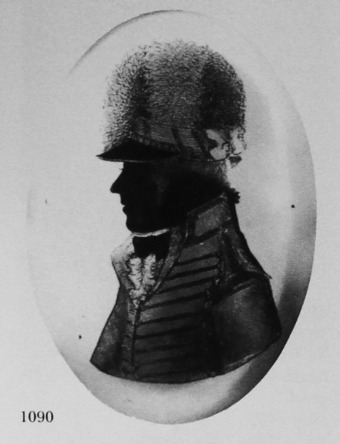
Unknown officer in a Volunteer Regiment
Silhouette painted on convex glass in umber, with detail in Chinese white
c. 1895-96
3 ½ x 2 ¾ in./90 x 70mm.
Frame: oval, hammered brass
Attributed to Mrs Hudson on stylistic grounds.
M. A. H. Christie collection
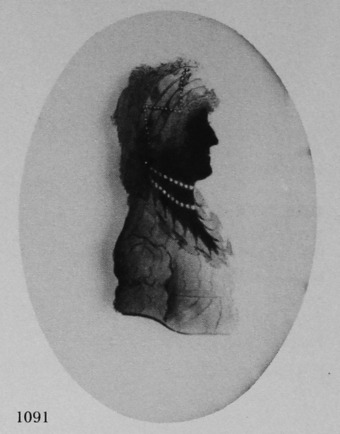
Unknown woman
Silhouette painted on convex glass, backed with pink plaster
1797
3 ¾ x 2 ¾ in./96 x 70mm.
Trade Label No. 2
Taken in Buxton. Mrs Hudson’s treatment of the stiff frill round the neck of the robe is interesting.
Author’s collection

Locket of gilt metal, containing a silhouette of Sarah Birch painted on convex glass (backed with ivory), by Mrs Elizabeth Hudson, mid-1790s.
Size of locket: 2 ¼ x 1 ¼ in./58 x 32mm.
A typical silhouette by Mrs Hudson.
The sitter’s costume suggests that the silhouette might have been taken while Mrs Hudson was working at Lewis Secard’s Gallery.
Elliott Levy collection
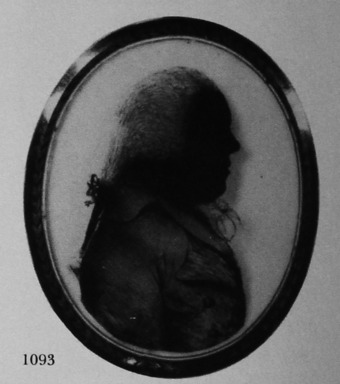
Gold locket, containing the silhouette of an unknown man painted on convex glass (backed with ivory), by Mrs Elizabeth Hudson, 1800-1802.
With verre églomisé border.
Size: 2 ¼ x 1 5/8 in./58 x 42mm.
The sitter’s clothing is painted in umber. Note the similarity in the treatment of the ribbons, and of the shading under the ‘step’ of the collar, to that in the artist’s silhouette of John Backhouse (115).
M. A. H. Christie collection
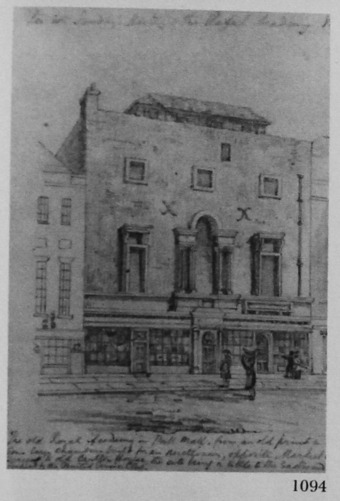
Drawing by John Coney (1796) of the original building in Pall Mall, London, in which the Royal Academy was housed. The drawing is inscribed (above), ‘See Wm. Sandby’s History of the Royal Academy’ and (below), ‘The Old Royal Academy in Pall Mall, from an old print in the British Museum. Some large chambers built for an auctioneer [James Christie] opposite to the Market House and adjacent to old Carlton House, the site being a little to the eastward of that occupied by the United Services Club’. On the left can be seen the windows of Secard’s Galler (See text: Mrs Elizabeth Hudson).
Guildhall, London (Print Room), by permission
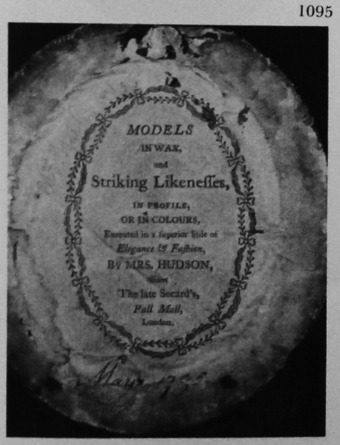
Trade Label No. 1 of Mrs Elizabeth Hudson.
J. A. Pollak collection

Trade Label No. 2 of Mrs Elizabeth Hudson.
Author’s collection
DETAIL
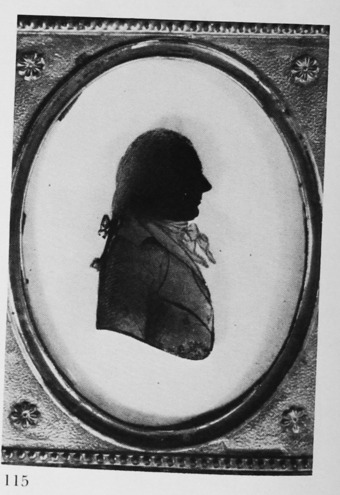
John Backhouse, of Wavertree Hill. Silhouette by Mrs Hudson, 1797. A man who, like this sitter, continued to wear a wig after the introduction of the Hair Powder Tax was referred to as a ‘Guinea.pig’.
SECTION THREE
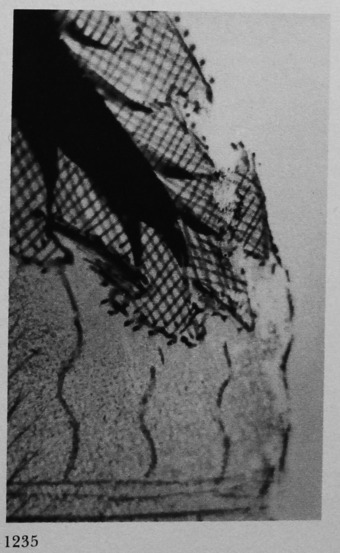
Front of a woman’s dress. Detail from a silhouette by Mrs Hudson. The dress is hatched and fingerprinted in a shade of sepia. (1091)
